
Mucuna is a genus of around 114 accepted species of climbing lianas (vines) and shrubs of the family Fabaceae: tribe Phaseoleae, typically found in tropical forests.

Inula is a genus of about 80 species of flowering plants in the family Asteraceae, native to Europe, Asia and Africa.

Tigridia, is a genus of bulbous or cormous flowering plants belonging to the family Iridaceae. With common names including peacock flowers, tiger-flowers or shell flowers, they have large showy flowers; and one species, Tigridia pavonia, is often cultivated for this. The approximately 35 species in this family grow in the Americas, from Mexico to Chile. The tigridia flower is short lived, each often blooming for only one day, but often several flowers will bloom from the same stalk. Usually they are dormant during the winter dry-season. The roots are edible and were eaten by the Aztecs of Mexico who called it cacomitl, and its flower ocēlōxōchitl "jaguar flower". The genus name Tigridia means "tiger-like", and alludes to the coloration and spotting of the flowers of the type species Tigridia pavonia.

Eupatorieae is a tribe of over 2000 species of plants in the family Asteraceae. Most of the species are native to tropical, subtropical, and warm temperate areas of the Americas, but some are found elsewhere. Well-known members are Stevia rebaudiana, a number of medicinal plants (Eupatorium), and a variety of late summer to autumn blooming garden flowers, including Ageratum (flossflower), Conoclinium (mistflower), and Liatris.

Emilia is a genus of herbaceous plants in the family sunflower family, known as tasselflower or pualele.

Astereae is a tribe of plants in the family Asteraceae that includes annuals, biennials, perennials, subshrubs, shrubs, and trees. They are found primarily in temperate regions of the world. Plants within the tribe are present nearly worldwide divided into over 250 genera and more than 3,100 species, making it the second-largest tribe in the family behind Senecioneae.

Anisopappus is a genus of flowering plants in the family Asteraceae.

Brachylaena is a genus of flowering plants in the aster family, Asteraceae. Several are endemic to Madagascar, and the others are distributed in mainland Africa, especially the southern regions.

Inuleae is a tribe of flowering plants in the subfamily Asteroideae.
Acritopappus is a genus of flowering plants in the family Asteraceae described as a genus in 1972.

Erythrocephalum is a genus of African flowering plants in the family Asteraceae.

Macledium is a genus of flowering plants in the family Asteraceae. Both Macledium and Dicoma are distributed largely in tropical and southern Africa. Macledium is distinguished from genus Dicoma by a large number of characters relating to morphology and anatomy of phyllaries, corolla, anthers, style, cypsela and testa.











